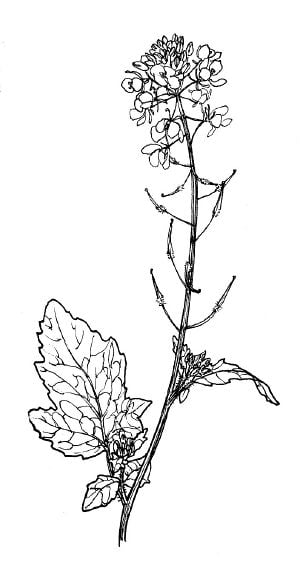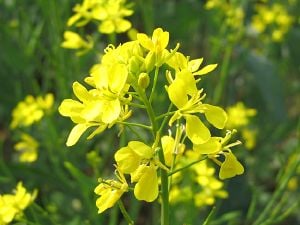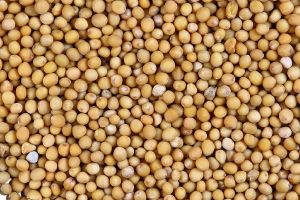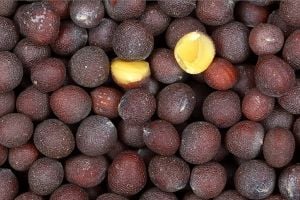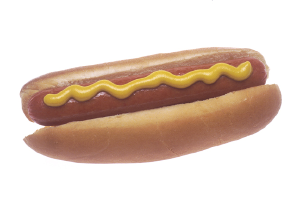Difference between revisions of "Mustard" - New World Encyclopedia
Rick Swarts (talk | contribs) |
Rick Swarts (talk | contribs) |
||
| Line 18: | Line 18: | ||
[[Image:Black-mustard-seeds.jpg|thumb|right|Black Mustard seeds]] | [[Image:Black-mustard-seeds.jpg|thumb|right|Black Mustard seeds]] | ||
| − | '''Mustard''' is the common name for several plant | + | '''Mustard''' is the common name for several [[herbaceous]] [[plant]]s in the [[genus|genera]] ''[[Brassica]]'' and ''[[Sinapis]]'' of the Brassicaceae family, and in particular ''Sinapis hirta'' or ''Sinapis alba'' (white or yellow mustard; sometimes classified in ''Brassica''), ''Brassica juncea'' (brown or Indian mustard), and ''Brassica nigra'' (black mustard), all three of whose small [[mustard seed]]s can be used as a [[spice]] and, by grinding and mixing them with water, vinegar, or other liquids, be turned into a [[condiment]] also known as mustard. The seeds are also pressed to make [[mustard oil]], and the [[leaf vegetable|edible leaves]] can be eaten as mustard greens. The term mustard sometimes is used as a collective name for all members of the genus Brassica (a taxon that also includes [[cabbage]], [[turnip]], [[raddish]], and other well-known [[vegetable]]s), and Brassicaceae is sometimes known as the "mustard family." |
| − | ==Description== | + | ==The mustard plant: Description and overview== |
The species of mustard belong to the [[flowering plant]] family '''Brassicaceae''' (or Cruciferae), also known as the crucifers, the mustard family, or the cabbage family. (Cruciferae is an older name for the family. It means "cross-bearing," because the four [[petal]]s of their flowers are reminiscent of a [[cross]].) | The species of mustard belong to the [[flowering plant]] family '''Brassicaceae''' (or Cruciferae), also known as the crucifers, the mustard family, or the cabbage family. (Cruciferae is an older name for the family. It means "cross-bearing," because the four [[petal]]s of their flowers are reminiscent of a [[cross]].) | ||
| − | The family contains species of great economic importance, providing much of the world's winter | + | The family contains species of great economic importance, providing much of the world's winter [[vegetable]]s. In addition to mustard, these include [[cabbage]], [[broccoli]], [[cauliflower]], [[brussels sprout]]s, [[collard]]s, and [[kale]] (all cultivars of one species, ''[[Brassica oleracea]]''), [[Chinese kale]], [[rutabaga]] (also known as Swedish turnips or swedes), [[seakale]], [[Brassica rapa|turnip]], [[radish]], and [[Kohl Rabi|kohl rabi]]. Other well known members of the Brassicaceae include [[rapeseed]] ([[canola]] and others), [[watercress]], [[horseradish]], and [[wasabi]]. |
| − | Brassicaceae consists only of [[herbaceous]] plants with annual, biennial or perennial lifespans. The '''[[leaf|leaves]]''' are [[phyllotaxis|alternate]] (rarely [[phyllotaxis|opposite]]), sometimes organized in basal [[rosette]]s. They are very often pinnately incised and do not have [[stipule]]s. | + | Brassicaceae consists only of [[herbaceous]] plants with annual, biennial, or perennial lifespans. The '''[[leaf|leaves]]''' are [[phyllotaxis|alternate]] (rarely [[phyllotaxis|opposite]]), sometimes organized in basal [[rosette]]s. They are very often pinnately incised and do not have [[stipule]]s. |
The structure of the '''[[flower]]s''' is extremely uniform throughout the family. They have four free saccate sepals and four clawed free [[petals]], staggered. They can be [[Floral symmetry|disymmetric]] or slightly [[Floral symmetry|zygomorphic]], with a typical cross-like arrangement. They have six [[stamen]]s, four of which are longer (as long as the petals, so relatively short in fact) and are arranged in a cross like the petals and the other two are shorter (''tetradynamous'' flower). The [[pistil]] is made up of two fused [[carpel]]s and the style is very short, with two lobes. Superior ovary. The flowers form ebracteate [[Inflorescence#simple_inflorescences|racemose]] inflorescences, often apically corymb-like. | The structure of the '''[[flower]]s''' is extremely uniform throughout the family. They have four free saccate sepals and four clawed free [[petals]], staggered. They can be [[Floral symmetry|disymmetric]] or slightly [[Floral symmetry|zygomorphic]], with a typical cross-like arrangement. They have six [[stamen]]s, four of which are longer (as long as the petals, so relatively short in fact) and are arranged in a cross like the petals and the other two are shorter (''tetradynamous'' flower). The [[pistil]] is made up of two fused [[carpel]]s and the style is very short, with two lobes. Superior ovary. The flowers form ebracteate [[Inflorescence#simple_inflorescences|racemose]] inflorescences, often apically corymb-like. | ||
| Line 34: | Line 34: | ||
Brassicaceae [[fruit]] is a peculiar kind of [[capsule (fruit)|capsule]] named siliqua (plural siliquae, American English silique/siliques). It opens by two valves, which are the modified carpels, leaving the [[seed]]s attached to a framework made up of the placenta and tissue from the junction between the valves (replum). There is often an indehiscent beak at the top of the style and one or more [[seeds]] may be borne there. Where a siliqua is less than three times as long as it is broad, it is usually termed a silicula. The siliqua may break apart at constrictions occurring between the segments of the seeds, thus forming a sort of [[loment]] (e.g. ''[[Raphanus]]''); it may eject the seeds explosively (e.g. ''[[Cardamine]]''); or may be evolved in a sort of [[samara]] (e.g. ''[[Isatis]]''). Unsurprisingly the fruit is often the most important diagnostic character for plants in this family. | Brassicaceae [[fruit]] is a peculiar kind of [[capsule (fruit)|capsule]] named siliqua (plural siliquae, American English silique/siliques). It opens by two valves, which are the modified carpels, leaving the [[seed]]s attached to a framework made up of the placenta and tissue from the junction between the valves (replum). There is often an indehiscent beak at the top of the style and one or more [[seeds]] may be borne there. Where a siliqua is less than three times as long as it is broad, it is usually termed a silicula. The siliqua may break apart at constrictions occurring between the segments of the seeds, thus forming a sort of [[loment]] (e.g. ''[[Raphanus]]''); it may eject the seeds explosively (e.g. ''[[Cardamine]]''); or may be evolved in a sort of [[samara]] (e.g. ''[[Isatis]]''). Unsurprisingly the fruit is often the most important diagnostic character for plants in this family. | ||
| − | '''''Brassica''''' | + | '''''Brassica''''' is one of the genus to which mustard belongs. The members of the genus may be collectively known either as cabbages, or as mustards. This genus is remarkable for containing more important [[agricultural]] and [[horticultural]] crops than any other genus. It includes over 30 wild species and hybrids, and numerous additional [[cultivar]]s and hybrids of cultivated origin. In addition to the mustards, the genus ''Brassica'' also includes [[cabbage]]s, [[cauliflower]], [[rapeseed]], ''Brussels sprouts]], and [[Turnip (Brassica rapa)|turnip]]s, among others. Most members of the genus are [[Annual plant|annual]]s or [[Biennial plant|biennial]]s, but some are small shrubs. The genus is native in the wild in western [[Europe]], the [[Mediterranean climate|Mediterranean]], and temperate regions of [[Asia]]. In addition to the cultivated species, which are grown worldwide, many of the wild species grow as weeds, especially in [[North America]], [[South America]], and [[Australia]]. |
| − | |||
| − | |||
| − | |||
| − | |||
| − | |||
| − | |||
| − | |||
| − | This genus is remarkable for containing more important [[agricultural]] and [[horticultural]] crops than any other genus. | ||
| − | |||
| − | The genus is native in the wild in western [[Europe]], the [[Mediterranean climate|Mediterranean]] and temperate regions of [[Asia]]. In addition to the cultivated species, which are grown worldwide, many of the wild species grow as weeds, especially in [[North America]], [[South America]], and [[Australia]] | ||
| − | |||
| − | |||
| − | |||
| − | |||
| − | |||
| − | |||
| − | |||
| − | |||
| − | |||
| − | |||
| − | |||
| − | |||
| − | |||
| + | Species of Brassica include several with the name mustard as part of their common name: | ||
* ''[[Brassica carinata|B. carinata]]'' - Abyssinian Mustard or Abyssinian Cabbage | * ''[[Brassica carinata|B. carinata]]'' - Abyssinian Mustard or Abyssinian Cabbage | ||
* ''[[Brassica elongata|B. elongata]]'' - Elongated Mustard | * ''[[Brassica elongata|B. elongata]]'' - Elongated Mustard | ||
| − | |||
* ''[[Brassica juncea|B. juncea]]'' - Indian Mustard, Brown and leaf mustards, Sarepta Mustard. | * ''[[Brassica juncea|B. juncea]]'' - Indian Mustard, Brown and leaf mustards, Sarepta Mustard. | ||
| − | |||
* ''[[Brassica narinosa|B. narinosa]]'' - Broadbeaked Mustard | * ''[[Brassica narinosa|B. narinosa]]'' - Broadbeaked Mustard | ||
* ''[[Brassica nigra|B. nigra]]'' - Black Mustard | * ''[[Brassica nigra|B. nigra]]'' - Black Mustard | ||
| − | |||
* ''[[Brassica perviridis|B. perviridis]]'' - Tender Green, Mustard Spinach | * ''[[Brassica perviridis|B. perviridis]]'' - Tender Green, Mustard Spinach | ||
| − | |||
* ''[[Brassica rupestris|B. rupestris]]'' - Brown Mustard | * ''[[Brassica rupestris|B. rupestris]]'' - Brown Mustard | ||
| − | |||
* ''[[Brassica tournefortii|B. tournefortii]]'' - Asian Mustard | * ''[[Brassica tournefortii|B. tournefortii]]'' - Asian Mustard | ||
| − | + | '''''Sinapis''''' is another genus of plants in the family Brassicaceae, one of whose species, ''Sinapis hirta'' or ''Sinapis alba'' is known as the white mustard or yellow mustard. It sometimes is known as ''Brassica hirta'' or ''Brassica alba''. [[Black mustard]] is sometimes placed in this genus of ''Sinapis'' as well, but is more often placed in the related genus ''[[Brassica]]''. | |
| + | |||
| + | The three main plants associated with mustard are ''Sinapis hirta'', ''Brassica juncea'', and ''Brassica nigra''. ''S. hirta'', known as mild white mustard grows wild in [[North Africa]], the [[Middle East]], and [[Mediterranean]] Europe and has spread farther by long [[cultivation]]. ''B. juncea'' is known as brown or Indian mustard and is originally from the foothills of the [[Himalaya]]. It is grown commercially in the United Kingdom]], [[Canada]], and the [[United States]]. ''B. nigra'' is known as black mustard and it is grown in [[Argentina]], [[Chile]], the [[United States|US]], and some European countries. | ||
| + | |||
| + | == History == | ||
| + | The [[Roman Empire|Romans]] most likely developed the prepared mustards we know today. They mixed unfermented [[grape]] juice, known as "[[must]]," with ground mustard seeds (called ''sinapis'') to form ''mustum ardens,'' or "burning must." | ||
| + | |||
| + | |||
| + | Canada grows 90% of all the mustard seed for the international market. The Canadian province of [[Saskatchewan]] produces almost half of the world's supply of mustard seed.<ref>[http://www.saskmustard.ca/growing/statistics.html "Mustard Statistics"] ''Saskatchewan Mustard Development Commission'' Retrieved November 14, 2007</ref> | ||
| + | |||
| − | |||
Although the varieties of mustard are well-established crops in [[Hellenistic]] and [[Roman Empire|Roman]] times, which leads to the assumption that it was brought into cultivation at an earlier time, Zohary and Hopf note that "there are almost no archeological records available for any of these crops." Wild forms of mustard and its relatives the [[radish]] and [[turnip]] can be found over west Asia and Europe, suggesting that their domestication took place somewhere in that area. However Zohary and Hopf conclude, "Suggestions as to the origins of these plants are necessarily based on linguistic considerations."<ref>Daniel Zohary and Maria Hopf, ''Domestication of plants in the Old World'', third edition (Oxford: University Press, 2000), p. 139</ref> | Although the varieties of mustard are well-established crops in [[Hellenistic]] and [[Roman Empire|Roman]] times, which leads to the assumption that it was brought into cultivation at an earlier time, Zohary and Hopf note that "there are almost no archeological records available for any of these crops." Wild forms of mustard and its relatives the [[radish]] and [[turnip]] can be found over west Asia and Europe, suggesting that their domestication took place somewhere in that area. However Zohary and Hopf conclude, "Suggestions as to the origins of these plants are necessarily based on linguistic considerations."<ref>Daniel Zohary and Maria Hopf, ''Domestication of plants in the Old World'', third edition (Oxford: University Press, 2000), p. 139</ref> | ||
| Line 86: | Line 67: | ||
'''Mustard''' is a thick yellowish-brown paste with a sharp taste<ref name=BBC>{{Citation |last= |first= |title=Making the most of... Mustard |url=http://www.bbc.co.uk/food/recipes/mostof_mustard.shtml |accessdate=2008-02-03}}</ref> made from the ground [[mustard seed|seeds]] of a [[mustard plant]] (white or yellow mustard, ''[[white mustard|Sinapis hirta]]''; brown or Indian mustard, ''[[Brassica juncea]]''; or black mustard, ''[[Brassica nigra]]''). The mustard seeds are mixed with [[water]], [[vinegar]] or other [[liquids]], as well as other flavorings and [[spices]]. A strong mustard can cause the [[eye]]s to water, burn the [[palate]] and inflame the [[nose|nasal]] passages. | '''Mustard''' is a thick yellowish-brown paste with a sharp taste<ref name=BBC>{{Citation |last= |first= |title=Making the most of... Mustard |url=http://www.bbc.co.uk/food/recipes/mostof_mustard.shtml |accessdate=2008-02-03}}</ref> made from the ground [[mustard seed|seeds]] of a [[mustard plant]] (white or yellow mustard, ''[[white mustard|Sinapis hirta]]''; brown or Indian mustard, ''[[Brassica juncea]]''; or black mustard, ''[[Brassica nigra]]''). The mustard seeds are mixed with [[water]], [[vinegar]] or other [[liquids]], as well as other flavorings and [[spices]]. A strong mustard can cause the [[eye]]s to water, burn the [[palate]] and inflame the [[nose|nasal]] passages. | ||
| − | + | ||
| − | |||
==Varieties== | ==Varieties== | ||
Revision as of 23:11, 15 April 2008
| Mustard | ||||||||||
|---|---|---|---|---|---|---|---|---|---|---|
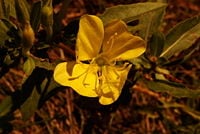 Wild Mustard (Brassica campestris)
| ||||||||||
| Scientific classification | ||||||||||
| ||||||||||
|
See text. |
Mustard is the common name for several herbaceous plants in the genera Brassica and Sinapis of the Brassicaceae family, and in particular Sinapis hirta or Sinapis alba (white or yellow mustard; sometimes classified in Brassica), Brassica juncea (brown or Indian mustard), and Brassica nigra (black mustard), all three of whose small mustard seeds can be used as a spice and, by grinding and mixing them with water, vinegar, or other liquids, be turned into a condiment also known as mustard. The seeds are also pressed to make mustard oil, and the edible leaves can be eaten as mustard greens. The term mustard sometimes is used as a collective name for all members of the genus Brassica (a taxon that also includes cabbage, turnip, raddish, and other well-known vegetables), and Brassicaceae is sometimes known as the "mustard family."
The mustard plant: Description and overview
The species of mustard belong to the flowering plant family Brassicaceae (or Cruciferae), also known as the crucifers, the mustard family, or the cabbage family. (Cruciferae is an older name for the family. It means "cross-bearing," because the four petals of their flowers are reminiscent of a cross.)
The family contains species of great economic importance, providing much of the world's winter vegetables. In addition to mustard, these include cabbage, broccoli, cauliflower, brussels sprouts, collards, and kale (all cultivars of one species, Brassica oleracea), Chinese kale, rutabaga (also known as Swedish turnips or swedes), seakale, turnip, radish, and kohl rabi. Other well known members of the Brassicaceae include rapeseed (canola and others), watercress, horseradish, and wasabi.
Brassicaceae consists only of herbaceous plants with annual, biennial, or perennial lifespans. The leaves are alternate (rarely opposite), sometimes organized in basal rosettes. They are very often pinnately incised and do not have stipules.
The structure of the flowers is extremely uniform throughout the family. They have four free saccate sepals and four clawed free petals, staggered. They can be disymmetric or slightly zygomorphic, with a typical cross-like arrangement. They have six stamens, four of which are longer (as long as the petals, so relatively short in fact) and are arranged in a cross like the petals and the other two are shorter (tetradynamous flower). The pistil is made up of two fused carpels and the style is very short, with two lobes. Superior ovary. The flowers form ebracteate racemose inflorescences, often apically corymb-like.
Pollination occurs by entomogamy; Nectar is produced at the base of the stamens and stored on the sepals.
Brassicaceae fruit is a peculiar kind of capsule named siliqua (plural siliquae, American English silique/siliques). It opens by two valves, which are the modified carpels, leaving the seeds attached to a framework made up of the placenta and tissue from the junction between the valves (replum). There is often an indehiscent beak at the top of the style and one or more seeds may be borne there. Where a siliqua is less than three times as long as it is broad, it is usually termed a silicula. The siliqua may break apart at constrictions occurring between the segments of the seeds, thus forming a sort of loment (e.g. Raphanus); it may eject the seeds explosively (e.g. Cardamine); or may be evolved in a sort of samara (e.g. Isatis). Unsurprisingly the fruit is often the most important diagnostic character for plants in this family.
Brassica is one of the genus to which mustard belongs. The members of the genus may be collectively known either as cabbages, or as mustards. This genus is remarkable for containing more important agricultural and horticultural crops than any other genus. It includes over 30 wild species and hybrids, and numerous additional cultivars and hybrids of cultivated origin. In addition to the mustards, the genus Brassica also includes cabbages, cauliflower, rapeseed, Brussels sprouts]], and turnips, among others. Most members of the genus are annuals or biennials, but some are small shrubs. The genus is native in the wild in western Europe, the Mediterranean, and temperate regions of Asia. In addition to the cultivated species, which are grown worldwide, many of the wild species grow as weeds, especially in North America, South America, and Australia.
Species of Brassica include several with the name mustard as part of their common name:
- B. carinata - Abyssinian Mustard or Abyssinian Cabbage
- B. elongata - Elongated Mustard
- B. juncea - Indian Mustard, Brown and leaf mustards, Sarepta Mustard.
- B. narinosa - Broadbeaked Mustard
- B. nigra - Black Mustard
- B. perviridis - Tender Green, Mustard Spinach
- B. rupestris - Brown Mustard
- B. tournefortii - Asian Mustard
Sinapis is another genus of plants in the family Brassicaceae, one of whose species, Sinapis hirta or Sinapis alba is known as the white mustard or yellow mustard. It sometimes is known as Brassica hirta or Brassica alba. Black mustard is sometimes placed in this genus of Sinapis as well, but is more often placed in the related genus Brassica.
The three main plants associated with mustard are Sinapis hirta, Brassica juncea, and Brassica nigra. S. hirta, known as mild white mustard grows wild in North Africa, the Middle East, and Mediterranean Europe and has spread farther by long cultivation. B. juncea is known as brown or Indian mustard and is originally from the foothills of the Himalaya. It is grown commercially in the United Kingdom]], Canada, and the United States. B. nigra is known as black mustard and it is grown in Argentina, Chile, the US, and some European countries.
History
The Romans most likely developed the prepared mustards we know today. They mixed unfermented grape juice, known as "must," with ground mustard seeds (called sinapis) to form mustum ardens, or "burning must."
Canada grows 90% of all the mustard seed for the international market. The Canadian province of Saskatchewan produces almost half of the world's supply of mustard seed.[1]
Although the varieties of mustard are well-established crops in Hellenistic and Roman times, which leads to the assumption that it was brought into cultivation at an earlier time, Zohary and Hopf note that "there are almost no archeological records available for any of these crops." Wild forms of mustard and its relatives the radish and turnip can be found over west Asia and Europe, suggesting that their domestication took place somewhere in that area. However Zohary and Hopf conclude, "Suggestions as to the origins of these plants are necessarily based on linguistic considerations."[2]
There has been recent research into varieties of mustards that have a high oil content for use in the production of biodiesel, a renewable liquid fuel similar to diesel fuel. The biodiesel made from mustard oil has good cold flow properties and cetane ratings. The leftover meal after pressing out the oil has also been found to be an effective pesticide. [1]
An interesting genetic relationship between many species of mustard has been observed, and is described as the Triangle of U.
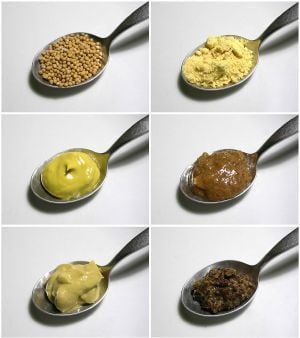
Mustard is a thick yellowish-brown paste with a sharp taste[3] made from the ground seeds of a mustard plant (white or yellow mustard, Sinapis hirta; brown or Indian mustard, Brassica juncea; or black mustard, Brassica nigra). The mustard seeds are mixed with water, vinegar or other liquids, as well as other flavorings and spices. A strong mustard can cause the eyes to water, burn the palate and inflame the nasal passages.
Varieties
| Mustard, yellow Nutritional value per 100 g | ||||||||||
|---|---|---|---|---|---|---|---|---|---|---|
| Energy 70 kcal 280 kJ | ||||||||||
| ||||||||||
| Percentages are relative to US recommendations for adults. Source: USDA Nutrient database | ||||||||||
There are many varieties of mustard which come in a wide range of strengths and flavors. The basic taste and "heat" of the mustard is largely determined by seed type, preparation and ingredients.[3][4] Black seeded mustard is generally regarded as the hottest type. Preparation also plays a key role in the final outcome of the mustard. Mustard, in its powdered form, lacks any potency; it is the production of Allyl isothiocyanate from the reaction of myrosinase and sinigrin that causes heat to be present.
Locations renowned for their mustard include Dijon (medium strength) and Meaux in France; Norwich (very hot) and Tewkesbury, famed for its variety, in the United Kingdom; and Düsseldorf (hot) and Bavaria in Germany. There are variations in the subsidiary spices and in the preparation of the mustard seeds. The husks may be ground with the seeds, or winnowed away after the initial crushing; "whole-grain mustard" retains some unground or partially ground mustard seeds. Bavarian "sweet mustard" contains very little acid, substituting copious amounts of sugar for preservation. Sometimes prepared mustard is simmered to moderate its bite, sometimes it is aged. Irish mustard is a wholegrain type blended with whiskey and or honey.
Dijon mustard
Dijon mustard is not covered by a Protected Designation of Origin (PDO) or a Protected Geographical Indication (PGI) under the auspices of the European Union; thus, while there are major mustard plants in Dijon and suburbs, most Dijon mustard is manufactured outside of Dijon.
Dijon mustard originated in 1856, when Jean Naigeon of Dijon substituted verjuice, the acidic "green" juice of not-quite-ripe grapes, for vinegar in the traditional mustard recipe.
Mustards from Dijon today generally contain both white wine and burgundy wine, and most mustards marketed as Dijon style today contain one or both of these ingredients.
Wholegrain
In wholegrain mustard, the seeds are not ground, but mixed whole with other ingredients. Different flavors and strengths can be achieved by using different blends of mustard seed species. Some variations have additives such as sun-dried tomato mustard and chili mustard.
Honey Mustard
Honey mustard, as the name suggests, is a blend of Dijon mustard and honey.[5] It is most often used as a topping for sandwiches and as a side for dipping french fries, onion rings, and other finger foods. It can also be used as a base for salad dressing when combined with vinegar and/or olive oil. The most basic form of honey mustard can be created by combining equal amounts of honey and mustard; however, most varieties incorporate other ingredients to add flavor, adjust texture, or change other properties.
Culinary uses
Mustard is most often used as a condiment on meat, especially cold meats. It is also used as an ingredient in mayonnaise and vinaigrette, in marinades and barbecue sauce. It can also be used as a base for salad dressing when combined with vinegar and/or olive oil. Mustard is a popular accompaniment to hot dogs and Bratwurst.
Dry mustard, typically sold in tins, is used in cooking and can be mixed with water to become prepared mustard.
Prepared mustard is generally sold in glass jars or plastic bottles. Prepared mustard stored for a long period of time is prone to separation, causing mustard water. Shaking the closed jar/bottle prior to opening is recommended.
Idioms
"To cut the mustard" means to achieve the desired standard.[6]
ReferencesISBN links support NWE through referral fees
- ↑ "Mustard Statistics" Saskatchewan Mustard Development Commission Retrieved November 14, 2007
- ↑ Daniel Zohary and Maria Hopf, Domestication of plants in the Old World, third edition (Oxford: University Press, 2000), p. 139
- ↑ 3.0 3.1 Making the most of... Mustard. Retrieved 2008-02-03
- ↑ What makes mustard hot?. Retrieved 2008-02-03
- ↑ Honey Mustard Sauce Recipe
- ↑ "cut the mustard"
See also
- Mount Horeb Mustard Museum
- Condiment
External links
Recipes
- Mustard recipes and sauces
- Mustard (seed) recipes
- Mustard recipes, from recipezaar.com
- Recipes with Mustard
- Recipe for honey mustard
- Recipe for honey mustard dressing
History
- Global Gourmet: Michele Anna Jordan on the history of a condiment
- The Golden History of Dijon Mustard
Other links
- Common Varieties of Mustard
- What Makes Mustard So Mustardy? (from The Straight Dope)
- World's Healthiest Foods: Mustard
- UCLA, Medicinal spices: Mustard
- Description of the many different edible types of mustard greens, on innvista.com
| Herbs and spices | |
|---|---|
| Herbs | Angelica • Basil • Basil, holy • Basil, Thai • Bay leaf • Boldo • Borage • Cannabis • Chervil • Chives • Coriander leaf (cilantro) • Curry leaf • Dill • Epazote • Eryngium foetidum (long coriander) • Hoja santa • Houttuynia cordata (giấp cá) • Hyssop • Lavender • Lemon balm • Lemon grass • Lemon verbena • Limnophila aromatica (rice paddy herb) • Lovage • Marjoram • Mint • Mitsuba • Oregano • Parsley • Perilla (shiso) • Rosemary • Rue • Sage • Savory • Sorrel • Stevia • Tarragon • Thyme • Vietnamese coriander (rau răm) • Woodruff |
| Spices | African pepper • Ajwain (bishop's weed) • Aleppo pepper • Allspice • Amchur (mango powder) • Anise • Aromatic ginger • Asafoetida • Camphor • Caraway • Cardamom • Cardamom, black • Cassia • Cayenne pepper • Celery seed • Chili • Cinnamon • Clove • Coriander seed • Cubeb • Cumin • Cumin, black • Dill seed • Fennel • Fenugreek • Fingerroot (krachai) • Galangal, greater • Galangal, lesser • Garlic • Ginger • Grains of Paradise • Horseradish • Juniper berry • Liquorice • Mace • Mahlab • Malabathrum (tejpat) • Mustard, black • Mustard, brown • Mustard, white • Nasturtium • Nigella (kalonji) • Nutmeg • Paprika • Pepper, black • Pepper, green • Pepper, long • Pepper, pink, Brazilian • Pepper, pink, Peruvian • Pepper, white • Pomegranate seed (anardana) • Poppy seed • Saffron • Sarsaparilla • Sassafras • Sesame • Sichuan pepper (huājiāo, sansho) • Star anise • Sumac • Tasmanian pepper • Tamarind • Turmeric • Wasabi • Zedoary |
Notes
Credits
New World Encyclopedia writers and editors rewrote and completed the Wikipedia article in accordance with New World Encyclopedia standards. This article abides by terms of the Creative Commons CC-by-sa 3.0 License (CC-by-sa), which may be used and disseminated with proper attribution. Credit is due under the terms of this license that can reference both the New World Encyclopedia contributors and the selfless volunteer contributors of the Wikimedia Foundation. To cite this article click here for a list of acceptable citing formats.The history of earlier contributions by wikipedians is accessible to researchers here:
The history of this article since it was imported to New World Encyclopedia:
Note: Some restrictions may apply to use of individual images which are separately licensed.
